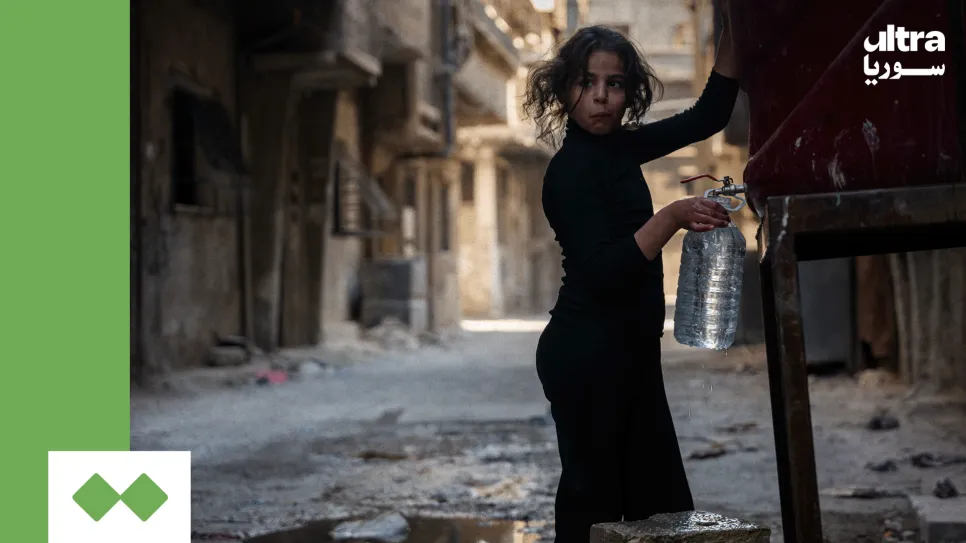Damascus, once nourished by the historic Barada River and the vital Fijeh Spring, now teeters on the edge of a severe water crisis. The capital and its surrounding countryside face a daily water shortfall of up to 200,000 cubic meters—an alarming figure that reflects both natural decline and chronic mismanagement.
With daily demand hovering between 500,000 and 550,000 cubic meters and supply lagging behind at approximately 350,000, authorities have scrambled to impose rationing and promote water-saving awareness campaigns. However, these short-term measures are proving inadequate as the crisis worsens.
Declining Sources and Diminishing Options
According to Imad Naami, Deputy Director of the Public Drinking Water Establishment in Damascus and its Countryside, emergency responses have included increased reliance on groundwater wells, stricter oversight of consumption, and community outreach in collaboration with various ministries. Yet these measures merely mask the underlying structural crisis: the depletion of Damascus’s main water source, the Fijeh Spring.
The Fijeh Spring, long regarded as the city’s lifeline, has seen its levels plummet due to ongoing drought conditions and below-average precipitation. This winter, rainfall reached only a third of the annual average, and snowfall—historically a key source of groundwater recharge—was virtually absent.
As authorities struggle to adapt, large-scale proposals like seawater desalination are being reconsidered. While studies are underway, the project faces formidable technical, financial, and geopolitical obstacles—not least of which are the lingering effects of international sanctions, only recently lifted.
Compounding the crisis is Syria’s diminished share of the Euphrates River. Despite international agreements governing water allocation among riparian states, Damascus has received far less than its expected quota in recent years, further narrowing alternatives for water supply.
Naami acknowledges that the Barada basin offers relatively stable well reserves. Most of these wells have been activated, with four more nearing completion. However, the scale of the crisis far exceeds these localized solutions.
A Deeper Analysis: Mismanagement and Over-Extraction
Water resource expert Dr. Ghada Bilal offers a more critical perspective. For her, the crisis is not merely about scarcity but a profound shift in hydrological realities—one that demands a systemic and scientifically grounded response.
She points to a pattern of unsustainable over-extraction of groundwater around the Fijeh Spring and surrounding fields, warning that this has disrupted ecological balance and accelerated aquifer decline. Even in seasons when groundwater levels typically rise, such as spring, excessive pumping—particularly for agriculture—has thwarted recovery.
Dr. Bilal argues that the solution lies not only in consumption controls but in the implementation of a comprehensive, integrated water resource management system. This approach must reconcile environmental, demographic, and economic pressures.
Among her recommendations: halting unauthorized groundwater extraction, expanding the diversity of water sources through rehabilitation of surface water systems, and enforcing legal protections around key springs like Fijeh and Barada. She also stresses the urgency of preventing groundwater pollution, which could jeopardize long-term water security.
As for desalination, Bilal is sceptical. She notes that producing just one cubic kilometre of desalinated water could cost upwards of $12–13, far beyond Syria’s current fiscal capabilities. Moreover, the technical challenges of producing the necessary filtration membranes domestically remain unresolved.
Instead, she advocates for more viable and cost-effective interventions: rainwater harvesting, protection of wetlands and reservoirs, and smarter agricultural water use. Sustainability, she insists, can only be achieved through integrated planning that aligns water usage with actual capacity and ecological limits.
Toward a National Water Strategy
The water crisis gripping Damascus is a stark reminder of the broader environmental and governance challenges facing Syria today. While officials are working to stabilize short-term supply, long-term solutions require far more than emergency drills.
What emerges from both official and expert assessments is the urgent need for a national water strategy—one that is not reactive but anticipatory; not fragmented, but holistic. Climate change, population growth, infrastructural decay, and regional geopolitics all intersect at the heart of Syria’s water dilemma.
Without such a strategy, the capital risks sliding from scarcity to catastrophe. For the nearly five million residents of Damascus and its outskirts, the promise of water security will remain dry unless met with bold, coordinated, and forward-looking action.
This article was translated and edited by The Syrian Observer. The Syrian Observer has not verified the content of this story. Responsibility for the information and views set out in this article lies entirely with the author.


